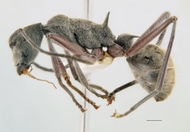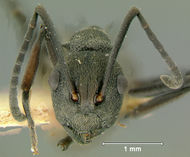Key to Australian Polyrhachis (Myrmhopla) species
The following key to Polyrhachis (Myrmhopla) species is based on Kohout (2010[1]).
1
- Larger species (head length > 2.00mm); all body surfaces, including appendages, with relatively long, erect hairs; appressed or suberect pubescence present in various densities but usually not completely hiding underlying sculpturation; gastral pubescence organised in midline pattern (sexspinosa-group) => 2
- Smaller species (head length < 2.00mm); body pilosity and pubescence highly variable between species-groups, from rather abundant to virtually lacking; gastral pubescence, if present, not forming midline pattern => 5
2
- Smaller species (head length < 2.70mm); head and anterior portion of mesosoma black with propodeum and petiole mostly reddish-brown; vertex of head coarsely rugose; pronotal dorsum rather smooth and polished or weakly and shallowly sculptured; short, sparse pubescence mostly greyish or white => Polyrhachis glabrinotum
- Larger species (head length > 3.00mm); head and body mostly black; dorsum of head and pronotum reticulate-punctate or rugose beneath rather long, golden or silvery pubescence => 3
3
- Head strongly tapered behind eyes; occipital margin narrow, forming lateral lobes that are more-or-less visible with head in full face view; antennal scapes relatively long (scape index > 190) => 4
- Head not strongly tapered behind eyes; occipital margin broad, without distinct lateral lobes; antennal scapes relatively short (scape index < 160) => Polyrhachis dispar
4
- Propodeal spines generally vertical to main axis of body or even inclined anteriorly; dorsum of head and mesosoma rather coarsely rugose => Polyrhachis sexspinosa
- Propodeal spines oblique to main axis of body, directed posteriorly; dorsum of head and mesosoma shallowly and finely sculptured beneath dense pubescence => Polyrhachis reclinata
5
- Body distinctly bicoloured; head and mesosoma black with gaster orange or light reddish-brown; appendages black, brown or orange (bicolor-group) => 6
- Body unicoloured, black, with appendages black or reddish-brown => 7
6
- Mandibles, apical antennal segments and gaster orange or light reddish-brown; antennal scapes and legs mostly black or very dark reddish-brown; mesosoma in lateral view with evenly convex outline => Polyrhachis nigripes
- Mandibles, antennae, legs and gaster orange or light reddish-brown; mesosoma in lateral view with mesonotum virtually flat => Polyrhachis bicolor
7
- Pronotal spines relatively long and slender; body black, closely and uniformly reticulate-punctate, opaque (dives-group) => Polyrhachis dives
- Pronotal spines reduced to minute teeth; body jet-black with legs and apical antennal segments black to medium reddish-brown; sculpturation consisting very fine, superficial reticulation with scattered shallow pits (mucronata-group) => Polyrhachis mucronata
















